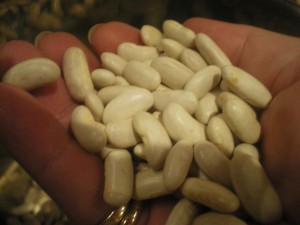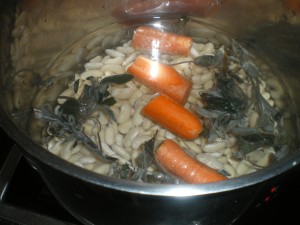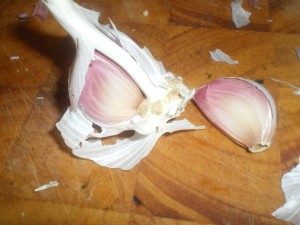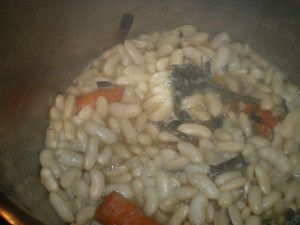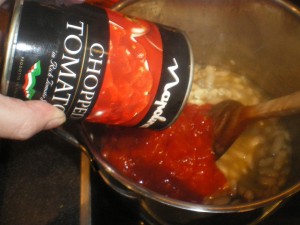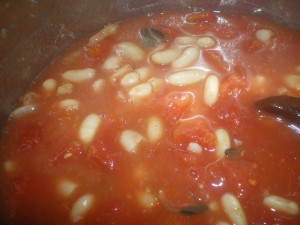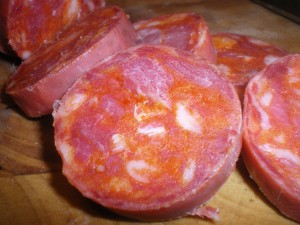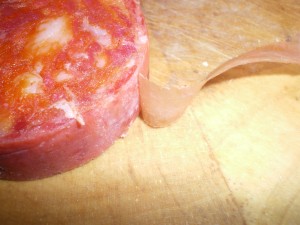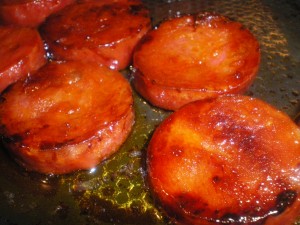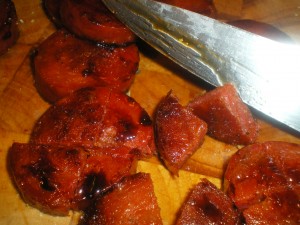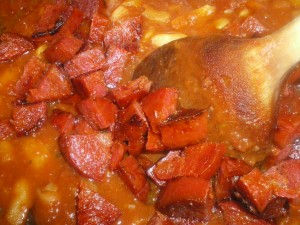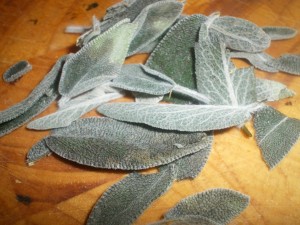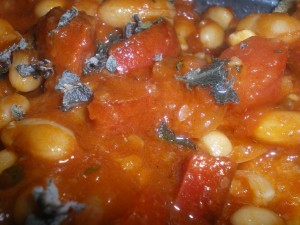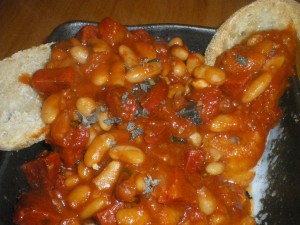When I want to cheer the Bear up, or give him a special treat, I tend to make him beans. It’s probably his favourite meal.
When he’s been travelling, he will phone from some far-flung corner of the world and ask me if I will make him beans on toast when he gets in.
This isn’t the ordinary, open a can, heat through and serve on white sliced sort of beans on toast… this is something that has developed in the time we have been together.
It all started when he asked me to marry him and I accepted (but you guessed that bit, right?) and then I went to Florence with my best friend for a little holiday. I have to point out, though, that this had been arranged for ages.. it wasn’t a reaction to being engaged. Anyway, D and I had a marvellous time, visiting her son and while we were there, often had cannellini beans with tomato and sage and pancetta, served with good Italian bread…. a traditional Tuscan dish. It is truly delicious – very simple but beautifully tasty.
I asked the chef at one restaurant, La Giostra how it was done. Now, I said these weren’t just any beans, nor was this just any chef…he is Prince Dimitri Kunz d’Asburgo Lorena.
It’s just beans he said…… cannellini beans in stock from vegetables, with some sage, olive oil, garlic, tomatoes and pancetta. But it’s slow…. you take your time. The flavours reflect the care you put into it.
When I came back I was telling the Bear about this wonderful restaurant, in a 16th Century building in the heart of Florence and how one of my favourite things had probably been this incredibly simple dish. He asked me to try and make it for him. And I did. I remembered what Prince Dimitri had said and I produced beans Tuscan style and it became a favourite of ours …. but as with all cooking, things change over time. I replaced, at one point, the pancetta with streaky bacon and chorizo, giving it a deeper, richer flavour and, after going out one day and leaving the beans bubbling down in the tomatoes until it became a thicker, more concentrated tomatoey bean dish, realised I liked it more with a thicker sauce. Maybe that’s because I’m not eating it in Florence….
I serve it with toasted No Knead Bread and we call it beans on toast.
First, get a bag of cannellini beans – you will need about 250g for maybe 4 or so healthy sized portions. Dried beans need to be soaked overnight to get them ready for their proper cooking.
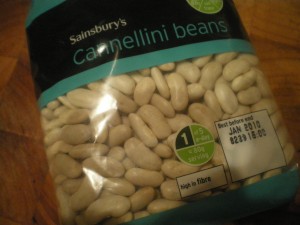
I once had dried beans that no matter what I did with them, they just refused to soften. Maybe they were a rogue batch, so after that I always made sure I had some cans of cannellini beans in as well. They are just as good and means that you can make beans that day, if you want them rather than waiting for the following day after they have soaked overnight.
So… either soak your beans and start the recipe the next day.. or open 3 cans of beans….
Give the beans a good rinse and then put them in a pot with some fresh water, some sprigs of sage and a carrot to add flavour to the stock.
Peel and chop 3 or 4 cloves of garlic (I cut it to roughly the size of the beans) and put them in the pot with a good slug of olive oil.
And then set the beans away – bring the pan to the boil, gently and then let them bubble softly away at a simmer until they soften. When I had that batch of beans that refused to soften I started adding a sheet of kombu to the pan (remembering to fish it out later) This is Japanese seaweed and it is supposed to help beans soften… it also adds a savour to the stock – more of the umami hit that makes everything taste so rich and full. Not seaweedy at all, so don’t worry. It’s not hard to get hold of if you want to give it a go – it will be in the health food/world food sections in supermarkets.
Let everything bubble away until you know the beans are softening. Or, if you are using cans of beans, just get them heated through for a few minutes in water, with the garlic and sage.
Now add two tins of chopped plum tomatoes
Stir it round – see how the beans are still distinctly white against the tomato? You want to get them to the stage where they are infused with tomatoey colour and flavour.
If you have some spare red wine, add a sloosh of that – maybe half a glass or so.
Turn the heat down so that you get the pan to bubble softly – the effect you are aiming for is for the occasional lazy bubble to pop to the surface. You can leave it doing that for an hour or so. You might need to add some more water – just keep half an eye on it and watch how it goes.
Now, get your chorizo and slice it
Don’t forget to pull off the covering around it… you don’t want to eat that.
Then dry fry it gently – see how the oil comes out?
You need to colour both sides and then take it out of the pan to cool before cubing it. Don’t throw that oil out… you pour that into the beans.
If you have streaky bacon, slowly fry that too and then cut that into pieces, before adding that and the chorizo to the beans.
Stir it all round and add another glug or two of olive oil.
Give it time to relax together – taste the sauce.. is it to your liking? Does it need some salt? It’s really only at this stage you add salt – if you do it as the beans are boiling you will toughen the skins.
Chop some sage leaves finely to scatter into the pot
It should be a rich tomato sauce with hints of the paprika from the chorizo, a slight muskiness from the sage, aromatic from the garlic and olive oil….
Slice and toast some good bread – and by that I mean sourdough or the lovely No Knead Bread, or maybe good Italian bread… just as long as it isn’t white sliced, which would just dissolve into nothingness.
And serve proudly, knowing you have made a meal from simple ingredients, that cost pennies and makes people smile.
